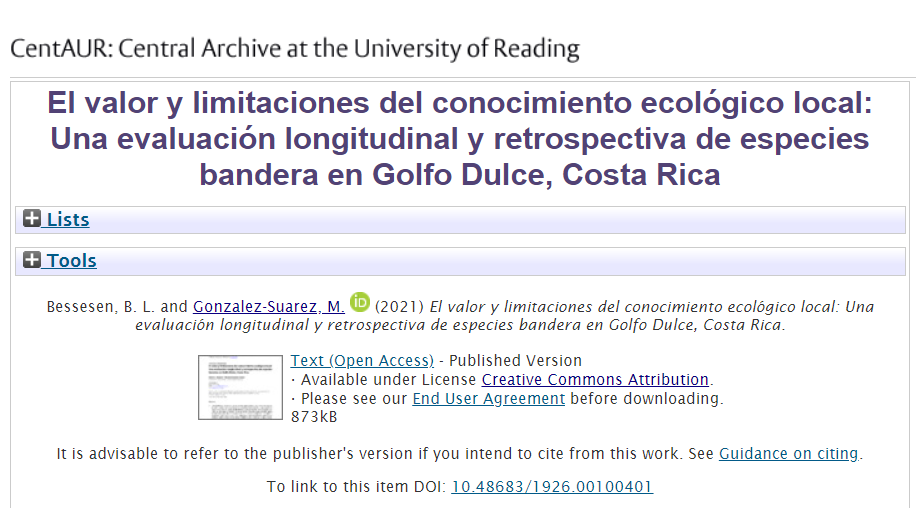
Publishing your work as open access (OA) with a creative commons licence allows your work to be accessed by everyone with an internet connection and also repurposed and built on by others with appropriate credit to you. In this interview for Open Access Week 2021, I spoke to PhD researcher Brooke Bessesen.

Please introduce yourself and tell us a bit about your research
I’m Brooke Bessesen, a PhD candidate in the department of Ecology and Evolutionary Biology at University of Reading under the supervision of Dr Manuela González-Suárez. My research takes place in a rare tropical fiord in southwestern Costa Rica, where I’ve been working as a principal investigator for more than a decade (though I started at Reading in 2019). My studies focus on the ecology of an endemic population of yellow sea snakes, Hydrophis platurus xanthos. But because the root of my research is understanding and conserving the embayment’s biodiversity, sometimes multiple species are involved, as is the case with our recent paper: ‘The value and limitations of local ecological knowledge: Longitudinal and retrospective assessment of flagship species in Golfo Dulce, Costa Rica’.
Why did you choose to publish your work in a fully open access journal? Why was open access important to you?
Open access was important to us on several levels. Whenever intellectual data comes from a community, those community members
deserve to know what was learned from their contributions.

Because our study was centered on interviews with local fishermen and tour boat guides, we wanted to make sure the findings were accessible to them. Also, because we hoped to serve conservation in a bio-rich area of Costa Rica that is currently under pressure, our work needed to reach as many stakeholders as possible. Through OA we were able to provide valuable assessment data to myriad policymakers and practitioners. On a more global level, we wanted to share insights about an interdisciplinary methodology that might help conservation biologists and social scientists surveying marine biodiversity in other parts of the world. Our goals were best achieved through OA.
How did you pay for the APC for the journal article? Was it easy to sort out the request and payment?
Because the University of Reading is a member of the Wiley JISC Read and Publish agreement, sorting out gold open access was very easy. The publisher identified the paper as originating from University of Reading via the corresponding author’s email address and just needed quick confirmation of eligibility from the Library’s open access requests team. The process was incredibly easy and didn’t involve me dealing with any invoices or purchase orders.
I can see that you also archived a dataset relating to your work using Figshare. What benefits do you think making the data set open brings to your research?
By providing our dataset, our results can be substantiated and potentially contribute to future research, as new questions may be answered by our efforts. The advantage of putting the dataset in Figshare is that it has a digital object identifier (DOI) of its own and can also be cited separately from the paper. The dataset can also be tracked for Altmetric attention.
Dataset citation: Bessesen, Brooke; Gonzalez Suarez, Manuela (2021): Local ecological knowledge regarding flagship species in Golfo Dulce, Costa Rica. figshare. Dataset. https://doi.org/10.6084/m9.figshare.14442029.v1
I know that there is now a Spanish translation of your work available so that the work is accessible by a wider audience and to the people living in the area of your study. Did publishing open access make it easier to distribute the translation?
The translation (by Daniel Colgan) stemmed from a request by Costa Rican government officials, but it was also an essential step toward knowledge-sharing in the community. Broad dissemination was made possible only because the original journal article was OA, and we were pleased to follow suit by making the Spanish version open access too (through a CC BY 4.0 license). It’s available on CentAUR with a DOI and can be freely downloaded by readers across Latin America and beyond.

Have you had any feedback or response to your work?

The original People and Nature article, which came out in May, has an Altmetric score of 5 (we appreciate the downloads and tweets and hope its reach will continue to grow). The translation was published in September, and government officials, local conservation directors, and our study participants have already expressed gratitude.
Do you have any tips or advice for others trying to publish open access or engage with open research? Given the growing focus on data sharing, there are more and more OA journals to choose from. And since institutional partnerships are usually listed, it’s possible to see if the university will assist with payment. While certain concerns can make full transparency of research findings imprudent (for example, localities of vulnerable taxa that might lead to exploitation), most investigations benefit from reaching a wider readership, potentially sparking future contributions and collaborations, and drawing the public audience into the journey of discovery.

Read Brooke’s Open Access article in People and Nature:
Bessesen, BL, González-Suárez, M. (2021) The value and limitations of local ecological knowledge: Longitudinal and retrospective assessment of flagship species in Golfo Dulce, Costa Rica. People Nat. 3: 627– 638. https://doi.org/10.1002/pan3.10219
Spanish translation:
Bessesen, B. L. and Gonzalez-Suarez, M. (2021) El valor y limitaciones del conocimiento ecológico local: Una evaluación longitudinal y retrospectiva de especies bandera en Golfo Dulce, Costa Rica. https://doi.org/10.48683/1926.00100401

 RSS - Posts
RSS - Posts